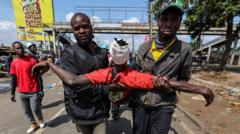The Independent Policing Oversight Authority (Ipoa) has come forth with strong accusations against the Kenyan police, claiming they employed "disproportionate force" in response to protests that erupted over the past several weeks, resulting in 65 deaths. In a report published on Thursday, the Ipoa specifically connected most of these fatalities to police actions. The document also points to the emergence of disruptive individuals, labeled "goons," who infiltrated the gatherings and compromised the ethos of peaceful protest.
The unrest has encompassed four separate protests throughout the last six weeks, instigated by mounting public outrage regarding police brutality and government policies. The first march, which took place in Nairobi on June 12, mobilized significant public support after the controversial death of a young teacher and blogger, Albert Ojwang, in police custody, which authorities initially attributed to self-inflicted injuries. Following this incident, three officers have been charged with murder.
The Ipoa recorded that a subsequent protest on June 17 culminated in the point-blank shooting of street vendor Boniface Kariuki, who ultimately perished from his injuries, with an officer implicated in the act. A protest on June 23, held in remembrance of a year since previous deadly demonstrations over tax increases, saw 23 additional deaths. The most devastating event occurred on July 7, as 41 civilians lost their lives during the protests.
The Ipoa highlighted significant breaches in police conduct across these events, with reports of 342 civilians and 171 police officers injured, alongside incidents of looting and vandalism directed at businesses and government offices. The report criticized the police for failing to uphold constitutional standards, citing a severe lack of professionalism during these confrontational encounters.
In a notable response to the protests, President William Ruto instructed police to shoot anyone aiming to burn or damage properties in the legs, aiming to disable rather than kill. This directive was met with criticism, as it was perceived as an endorsement of violent tactics against citizens.
Countering claims of excessive force, Interior Minister Kipchumba Murkomen classified the violence and protests as acts of "terrorism disguised as dissent," characterizing them as unconstitutional efforts to destabilize the government. Advocacy groups continue to denounce the administration's methods, asserting that authorities have not only supported but sometimes incited violent reprisals against demonstrators, raising severe concerns regarding human rights and the rule of law in Kenya.






















